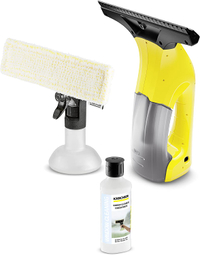The two main causes of frost on the inside of windows, and three ways to prevent it
Frosty windows can be magical during the holidays – as long as the frost is outside, that is. Here is what to do if the frost has made its way indoors


Gabriella Dyson
Frost on the inside of windows may not be uncommon if you are used to living in freezing cold climates, but for anyone else, it can be a rather alarming sight – especially if it's your first time experiencing sudden drops in outdoor temperatures.
While a little frost may not be cause for concern, large patches can be a sign of window damage or high indoor humidity, both of which can be harmful to your home in the winter months.
Here, experts explain what causes frost on the inside of windows and what you can do to prevent it.
What causes frost on the inside of windows?
‘Frost on the inside of windows is often caused by cold, leaky air coming into contact with condensation build-up on the inside of a window,’ says Jason Orme, speaker at the Homebuilding & Renovating Shows, and author of The Self Build Dream. ‘Given that cooler air holds less water than warmer air, the cooler the internal temperature of your home, the more likely condensation is to form on glass panes. Even if you have a powerful heating system, leaking windows are still likely to condense water.’
Although any window can be affected by internal frost, sliding windows are more susceptible to frost damage than others. Often found on houses in traditionally warmer climates, these types of windows are less able to form an air-tight seal around the frame, allowing outside air to leak indoors.

Jason is an experienced self-builder and has recently finished renovating his 1960s home. He is the Managing Director of Future PLC's Homes portfolio, which includes UK-leading titles such as Ideal Homes, Livingetc, and Homes & Gardens. He is also the author of The Self Build Dream. You can catch Jason in the seminar theatres and Advice Centre at many of the Homebuilding & Renovating Shows across the UK.
How to prevent frost on the inside of windows
Luckily, getting rid of frost on the inside of windows is often as simple as controlling the contributing factors.
1. Determine the cause of the frost to treat it at its source

When trying to prevent frost on the inside of windows, you will need to determine whether your frost is caused by excess humidity, a leaky window frame, or a combination of the two. If there is an air leak letting freezing air into your home and hot air out, for example, your main priority will be to weatherproof windows. Block the gaps with sealant to prevent cold drafts that can freeze condensation.
If frost stems primarily from high indoor humidity, then turning up your home heating and investing in a dehumidifier can help to combat surplus moisture in the air. This combination will not only help to dry your home out but keep it warmer throughout winter too.
2. Ensure your insulation is sufficient and there are no gaps and cracks around the window

‘Making sure your home is better insulated can also really help when tackling condensation and dampness,’ says Adam Pawson from leading window retailer, Safestyle. ‘Double glazing, wall insulation, and draft-proofing will help to reduce the amount of heat that is lost in your home. Having well-installed, energy-efficient windows will help to keep the property's temperature high, which can have a massive impact on condensation and mold growth.’
There is some debate as to whether you should insulate your basement ceiling or not, but the general consensus is that both basement and attic wall insulation will greatly improve the energy efficiency of your home.
3. Avoid making condensation worse to prevent a build-up of freezable water on windows

Understanding how to get rid of condensation inside windows is a great way to prevent frost from developing. However, it is important not to undo your hard work by making existing condensation worse.
‘Reducing how much moisture is in the air can have a huge impact on tackling condensation dampness,' says Adam Pawson. 'Little changes such as having your tumble dryer vented outside and hanging washing in airy spaces, instead of drying it inside warm rooms, can really help to keep moisture at bay.'
If you do start to see water beads appearing on or around your windows when the temperature outside begins to drop, make sure that you’re clearing the area on a daily basis. We suggest using a microfiber cloth to remove dampness before applying any cleaning solution. You could also use a window vac to make light work of this task.
When carrying out daily tasks such as cooking or showering, making sure you turn on the exhaust fan 10 or 20 minutes beforehand will help to create an air stream to carry excess moisture outside and prevent condensation build-up too.
Karcher WV 1 Plus Window Vacuum Squeegee | Was $79.99, now $49.99
This window vac and squeegee won't just help you vacuum away condensation - it can also be used to clean windows, eliminating streaks speedily.
Frost on the inside of windows in extremely cold temperatures is relatively normal. However, in milder climates, frost on the inside of windows could be a sign of a gap, damage, or improper insulation. If this is a regular occurrence, it's time to look into upgrading your windows or attempting some DIY draft-proofing solutions.
Sign up to the Homes & Gardens newsletter
Design expertise in your inbox – from inspiring decorating ideas and beautiful celebrity homes to practical gardening advice and shopping round-ups.

Chiana has been at Homes & Gardens for two years and is our resident 'queen' of non-toxic living. She spends most of her time producing content for the Solved section of the website, helping readers get the most out of their homes through clever decluttering, cleaning, and tidying tips. She was named one of Fixr's top home improvement journalists in 2024.
- Gabriella DysonContributor
-
 Do you need to turn the lights off when you leave a room? Experts have ended this time-honored debate once and for all
Do you need to turn the lights off when you leave a room? Experts have ended this time-honored debate once and for allOn or off? We delve into the details of this age-old dispute
By Chiana Dickson
-
 This Tudor decorating technique brings a 'cocooning' feel to Jon Bon Jovi's living room – but designers warn you need to be brave to follow his example
This Tudor decorating technique brings a 'cocooning' feel to Jon Bon Jovi's living room – but designers warn you need to be brave to follow his exampleThe singer uses wood to design a room that feels 'welcoming and rich in materiality,' but this century-old method comes with a warning
By Megan Slack
